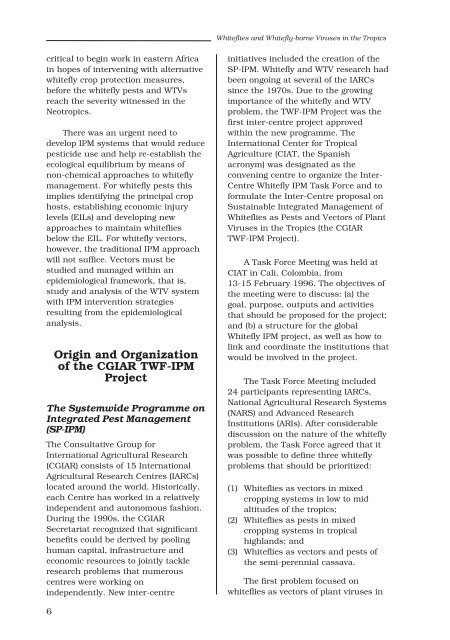Whitefly and whitefly-borne viruses in the tropics : Building a ... - cgiar
Whitefly and whitefly-borne viruses in the tropics : Building a ... - cgiar
Whitefly and whitefly-borne viruses in the tropics : Building a ... - cgiar
You also want an ePaper? Increase the reach of your titles
YUMPU automatically turns print PDFs into web optimized ePapers that Google loves.
critical to beg<strong>in</strong> work <strong>in</strong> eastern Africa<br />
<strong>in</strong> hopes of <strong>in</strong>terven<strong>in</strong>g with alternative<br />
<strong>whitefly</strong> crop protection measures,<br />
before <strong>the</strong> <strong>whitefly</strong> pests <strong>and</strong> WTVs<br />
reach <strong>the</strong> severity witnessed <strong>in</strong> <strong>the</strong><br />
Neo<strong>tropics</strong>.<br />
There was an urgent need to<br />
develop IPM systems that would reduce<br />
pesticide use <strong>and</strong> help re-establish <strong>the</strong><br />
ecological equilibrium by means of<br />
non-chemical approaches to <strong>whitefly</strong><br />
management. For <strong>whitefly</strong> pests this<br />
implies identify<strong>in</strong>g <strong>the</strong> pr<strong>in</strong>cipal crop<br />
hosts, establish<strong>in</strong>g economic <strong>in</strong>jury<br />
levels (EILs) <strong>and</strong> develop<strong>in</strong>g new<br />
approaches to ma<strong>in</strong>ta<strong>in</strong> whiteflies<br />
below <strong>the</strong> EIL. For <strong>whitefly</strong> vectors,<br />
however, <strong>the</strong> traditional IPM approach<br />
will not suffice. Vectors must be<br />
studied <strong>and</strong> managed with<strong>in</strong> an<br />
epidemiological framework, that is,<br />
study <strong>and</strong> analysis of <strong>the</strong> WTV system<br />
with IPM <strong>in</strong>tervention strategies<br />
result<strong>in</strong>g from <strong>the</strong> epidemiological<br />
analysis.<br />
6<br />
Orig<strong>in</strong> <strong>and</strong> Organization<br />
of <strong>the</strong> CGIAR TWF-IPM<br />
Project<br />
The Systemwide Programme on<br />
Integrated Pest Management<br />
(SP-IPM)<br />
The Consultative Group for<br />
International Agricultural Research<br />
(CGIAR) consists of 15 International<br />
Agricultural Research Centres (IARCs)<br />
located around <strong>the</strong> world. Historically,<br />
each Centre has worked <strong>in</strong> a relatively<br />
<strong>in</strong>dependent <strong>and</strong> autonomous fashion.<br />
Dur<strong>in</strong>g <strong>the</strong> 1990s, <strong>the</strong> CGIAR<br />
Secretariat recognized that significant<br />
benefits could be derived by pool<strong>in</strong>g<br />
human capital, <strong>in</strong>frastructure <strong>and</strong><br />
economic resources to jo<strong>in</strong>tly tackle<br />
research problems that numerous<br />
centres were work<strong>in</strong>g on<br />
<strong>in</strong>dependently. New <strong>in</strong>ter-centre<br />
Whiteflies <strong>and</strong> <strong>Whitefly</strong>-<strong>borne</strong> Viruses <strong>in</strong> <strong>the</strong> Tropics<br />
<strong>in</strong>itiatives <strong>in</strong>cluded <strong>the</strong> creation of <strong>the</strong><br />
SP-IPM. <strong>Whitefly</strong> <strong>and</strong> WTV research had<br />
been ongo<strong>in</strong>g at several of <strong>the</strong> IARCs<br />
s<strong>in</strong>ce <strong>the</strong> 1970s. Due to <strong>the</strong> grow<strong>in</strong>g<br />
importance of <strong>the</strong> <strong>whitefly</strong> <strong>and</strong> WTV<br />
problem, <strong>the</strong> TWF-IPM Project was <strong>the</strong><br />
first <strong>in</strong>ter-centre project approved<br />
with<strong>in</strong> <strong>the</strong> new programme. The<br />
International Center for Tropical<br />
Agriculture (CIAT, <strong>the</strong> Spanish<br />
acronym) was designated as <strong>the</strong><br />
conven<strong>in</strong>g centre to organize <strong>the</strong> Inter-<br />
Centre <strong>Whitefly</strong> IPM Task Force <strong>and</strong> to<br />
formulate <strong>the</strong> Inter-Centre proposal on<br />
Susta<strong>in</strong>able Integrated Management of<br />
Whiteflies as Pests <strong>and</strong> Vectors of Plant<br />
Viruses <strong>in</strong> <strong>the</strong> Tropics (<strong>the</strong> CGIAR<br />
TWF-IPM Project).<br />
A Task Force Meet<strong>in</strong>g was held at<br />
CIAT <strong>in</strong> Cali, Colombia, from<br />
13-15 February 1996. The objectives of<br />
<strong>the</strong> meet<strong>in</strong>g were to discuss: (a) <strong>the</strong><br />
goal, purpose, outputs <strong>and</strong> activities<br />
that should be proposed for <strong>the</strong> project;<br />
<strong>and</strong> (b) a structure for <strong>the</strong> global<br />
<strong>Whitefly</strong> IPM project, as well as how to<br />
l<strong>in</strong>k <strong>and</strong> coord<strong>in</strong>ate <strong>the</strong> <strong>in</strong>stitutions that<br />
would be <strong>in</strong>volved <strong>in</strong> <strong>the</strong> project.<br />
The Task Force Meet<strong>in</strong>g <strong>in</strong>cluded<br />
24 participants represent<strong>in</strong>g IARCs,<br />
National Agricultural Research Systems<br />
(NARS) <strong>and</strong> Advanced Research<br />
Institutions (ARIs). After considerable<br />
discussion on <strong>the</strong> nature of <strong>the</strong> <strong>whitefly</strong><br />
problem, <strong>the</strong> Task Force agreed that it<br />
was possible to def<strong>in</strong>e three <strong>whitefly</strong><br />
problems that should be prioritized:<br />
(1) Whiteflies as vectors <strong>in</strong> mixed<br />
cropp<strong>in</strong>g systems <strong>in</strong> low to mid<br />
altitudes of <strong>the</strong> <strong>tropics</strong>;<br />
(2) Whiteflies as pests <strong>in</strong> mixed<br />
cropp<strong>in</strong>g systems <strong>in</strong> tropical<br />
highl<strong>and</strong>s; <strong>and</strong><br />
(3) Whiteflies as vectors <strong>and</strong> pests of<br />
<strong>the</strong> semi-perennial cassava.<br />
The first problem focused on<br />
whiteflies as vectors of plant <strong>viruses</strong> <strong>in</strong>
















